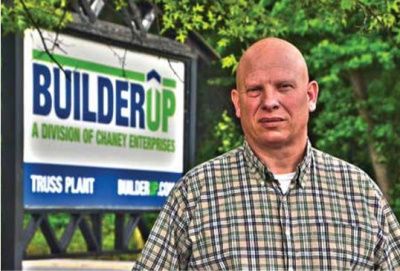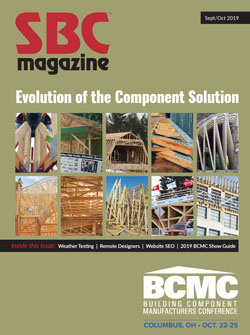Faces of the Industry: John Howlin
Faces of the Industry: John Howlin
Manufacturing Manager • BuilderUp • Gambrills, MD

How’d you get into this industry?
In a lot of ways, I grew up in the industry as this was the family business. My uncle and father were home builders. In the mid 1970’s they were having problems getting lumber and trusses delivered on schedule, so they started a lumber yard and then bought a truss plant. After college, I was working in juvenile probation and living in northern Virginia. My wife and I decided to move to Maryland. After commuting for just under a year, we started looking at other options after she became pregnant. I reached out to my father to see if they had any open positions in the company. They had been looking for a production supervisor at the truss plant, so after meeting with the truss plant manager, I was able to join the family business.
What’s your favorite part about being in this industry? What could you do without?
There are two parts that I truly enjoy. One is the relationships you build with your customers. Having the opportunity to establish these relationships not only helps build the business but makes working with them that much more enjoyable. If you build the trust and the relationship by treating them how you want to be treated and giving them the truth up front, then it makes the job that much easier. When things are bad, a good relationship is one in which a customer will be upset but I don’t worry about them running to my competition or having a complete meltdown. I’ll listen and after about ten minutes we’ll begin to talk about how we fix the situation. If my competition comes knocking on their door, I get a phone call. I don’t spend a lot of time looking over my shoulder with long-term customers. They know they can reach out if they have a problem, or they can call and we have a conversation and get past it. Every day is an adventure in this industry. Whether it is a customer, employee, supplier, there always seems to be a new challenge or obstacle that keeps every day interesting.
What could you do without?
The constant struggle to find good help. Despite experiencing it for 20 years, it still amazes me how little people understand the “requirements” to work. One problem we face is the constant turnover, too many people come to work not understanding what expectations are. Some are 15 minutes late every day, which amounts to two hours a week. Showing up on time and giving an honest effort are a thing of the past. Plus, since we require a drug test to work, we tend to narrow the pool quickly right from the get-go.
Since the last recession, we have seen a decrease in the value of being a service-oriented company. We have always prided ourselves on going the extra mile to make sure our customers had what they need when they needed it, and honestly that was built into our cost. Before the recession, everyone understood that you have a designer in your office who will do the design for you. Now, everyone still understands that but they do not want to pay for it. Our customers expect us to keep that same service and match pricing from our competitors, many of whom do not offer the service side of the business. It’s a fine line but we have to ask, “what are we getting paid for?” Do we continue to get treated as a commodity or are we selling the service to sit down and talk with the designer and spend time to make sure it is exactly what the customer wants. We have spent much more time looking at each customer’s value to determine what each customer wants and playing to our strengths, which is our service. This helps us focus on the value the customer is looking for.
What’s your company focused on right now?
Our company is currently going through some change. We have a new general manager (as of June 2019) and with this brings some great opportunities. Our new general manager has let us know that we are getting back to basics. We are to get out and see our customers, visit their jobsites, rebuild the relationships that were lost with the previous management changes in 2017. We are working to empower our sales and design staff so they can start to make decisions that are good for the company and their customers. Our design staff has been given leeway to make the sale, within reason, so their time is put to better use. We pay them whether they make a sale or are just working a quote, so let’s make the sale. Plus, they have a feel for the customer, and they have the customer in front of them. Rather than checking with the boss, we have given them the ability to figure out the sale. Having the opportunity to make a judgment call with the person in front of them is of huge value to the customer. They like the immediate answer, working with only one person, and walking out the door feeling like they have everything figured out. Since we have given our designers this opportunity, we have seen a 15-20 percent increase in jobs being sold in the first meeting before they can price with our competitors.
What challenges do you see for the industry in the future, and what should SBCA be working on now to meet those challenges?
Labor continues to be the biggest challenge we face. There have been great strides in automation in the industry and that seems to be the most effective solution. It has created a side problem that has changed who we are recruiting for positions. Now, our employees must be computer literate and able to do more than just turn on a computer. They need to be able to work in the programs and function at a higher level. So now we are not searching for “laborers,” we are trying to find laborers with some computer skills. This has made us rethink who we are hiring and has shrunk our labor pool. We are also focused on our retention efforts. With the high cost of training new employees, we have a main point of contact for employees, somebody who is not their immediate supervisor. With our onboarding program, new employees don’t feel lost and have somebody they can constantly go to. The line of communication from the shop to the office has really opened up, and we have management in front of employees on a more regular basis to answer questions and discuss what is going on in the company.
When you’re not thinking about trusses, what keeps you busy?
My wife, Catherine, and I have two boys. One is currently in the US Navy and stationed in Jacksonville, Florida. The other is a senior in high school with aspirations to attend college. In my free time, I volunteer with the Boy Scouts of America. I have been volunteering since my oldest son was in second grade. I have held many positions over the years and since my boys are older (and both Eagle Scouts) my focus has been working on training leadership programs for both adult leaders and our youth leaders. I have been fortunate to serve and lead several courses, which has truly become my passion outside of family and work.

